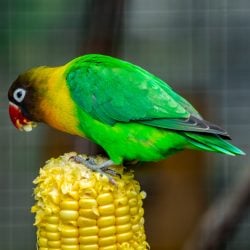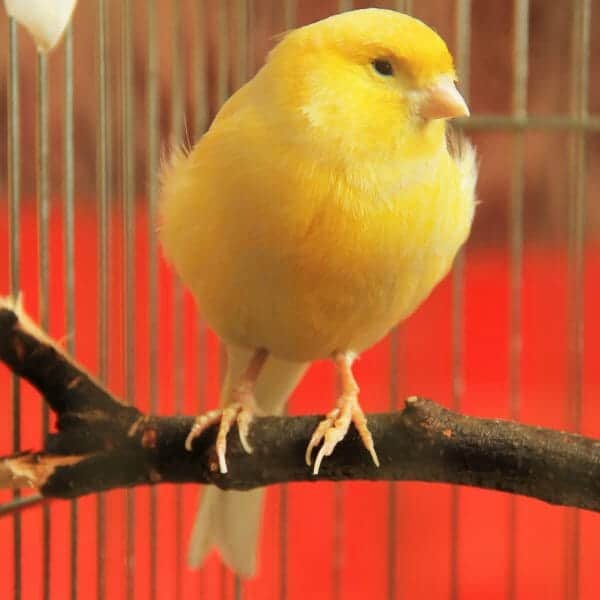Last Updated on by Mitch Rezman
We offer USDA certified organic bird food pellets from Harrison’s.
It’s refuted as one of the best bird foods on the market.
We also offer Totally Organics, another fine organic blend.
The biggest misconception about organic is its purity. The majority of people assume organic means fully natural and pesticide-free but this is not close to the truth.
If you visit this page on the US Government’s USDA site you’ll learn that pesticides are an accepted practice for any category of organic food as long as the “Pesticides (are) derived from natural sources (e.g., biological pesticides) may also be used in producing organically grown food.”
The reality is that organic farmers for the most part use more pesticides than non-organic farmers.
If an organic farm is anywhere near a large city, rainwater helping the plants grow is laced with all the pollutants in the air from the city.
Studies done by universities in Boston, Kansas City, and L.A. sited dangerously high levels of lead that had leached into the soil of these 3 cities all serving urban organic farmers.
We’ll let you draw your own conclusions.
Myth 2: Never use sandpaper or grooming perches in your bird’s cage.
A recent article I read by a renowned avian veterinarian denounced “sandpaper covers” over perches and should never be used.
Ask 9 out of 10 vets what they think of grooming perches and they will tell you to stay away from them because they can cause bumblefoot or open foot sores.
me
With the smallest of birds like canaries, finches, and even budgies, birds that you are not typically going to physically handle outside of the cage, the length of their nails isn’t much of an issue unless they grow so long they cannot hold onto perches nor get around comfortably.
Some sort of nail trimming has to take place.
Canaries and finches are soft bills so beak trimming is not a problem but once we get into Cockatiels, Conures, or hookbill parrots in general that we expect to have interaction with outside the cage, nails, and beaks need to be cared for.
Extra sharp nails cling to clothing making the transfer of a bird from your clothing sleeve to your hand a bit tricky.
Birds, especially Eclectus parrots can have beak overgrowth issues with 100% seed diets.
Out-of-control beak growth has to be dealt with. An overly long beak may also be a sign of liver problems so a visit to your avian vet would be in order.
Here’s the thing. As worrisome a thought of wrestling 1 pound (the average weight of an African Grey) of feathers and muscle for 2 minutes to trim eight nails some people prefer not to deal with it.
So while the Vets tell us what not to do, they don’t tell us how to solve the problem.
With grooming perches, it isn’t their “use”, it’s their “placement”
We have no argument with the fact that if a bird spends 12 plus hours or more a day on a grooming perch it will eventually encounter foot problems.
Yet an amazing amount of caged bird keepers we speak with, use bird grooming perches as bird sleeping perches.
We avoid this problem by placing the grooming perch next to a feeder cup or inside the birdcage door.
Feeder cups are often lower in the cage and birds visit them when they are hungry for 10 to 30 minutes a day.
Birds tend to be very active while eating which is the perfect time to be on a grooming perch because now their nails are actually getting worn down.
Most hookbills will also swipe their beak on the perch to remove food particulate.
By wiping their beaks on a grooming perch they are keeping their beaks in optimal shape much like a chef using a honing steel to remove the burrs off a recently sharpened knife.
When they’re done eating they will usually move to a higher area in the cage with the fresh pedicure. No toweling nor screaming while the nail points that stick to your cotton shirt or blouse get removed.
Myth 3: Most paints and coatings contain heavy metals that birds can ingest as they use their beaks to climb around the cage.
First, full transparency. Back in the 90s, I managed a powder coating facility specializing in the re-powder coating of foodservice shelving.
As a retailer of bird cages, I can speak with authority about the implications of powder coating on a birdcage or any other metal substrate.
Let’s talk about paint first.
Although rare these days, a birdcage painted by a birdcage manufacturer uses water-based paint.
Further, and I talk about repainting bird cages in this article, paint is not your enemy on a birdcage.
It’s the VOCs – Volatile Organic Compounds – released into the air as the paint dries – the stuff you smell.
VOC’s dissipate into the air as the paint dries and then becomes a non-issue.
As for powder coating – there are no metals in the powder to poison your bird.
The powder must melt long before the cage metal does for it to become the “coat” in powder coat.
Sorry, doc – ain’t no sunshine when she’s gone and ain’t no metal in the “paint” on a birdcage.
Great Bill Withers cover
Editor’s note: Powder particles (prior to melting) range from 2 to 50 μ (Microns), there are 25,400 microns per inch.
It’s usually a plastic or nylon based powder that literally bonds to the substrate (the metal the cage is made out of) under high heat.
Because powder coating bonds on a molecular basis to the base metal under high heat the only reason the powder coating is peeling off your bird cage is
A) you bought a crappy cage
or
B) you are under the misguided impression that only way to clean a cage is to take it to the backyard and pressure wash it, as the best and most efficient way to clean it.
Crappy cages are sold all the time on “wholesale” websites, Amazon or eBay.
They have no recognizable brand name.
You can’t e-mail or call them and ask if you get a copy of their assay or test report indicating things like the percentage of zinc in the metal.
An assay (lab report) is available from any of the US-based name brand birdcage importers.
No bird cages are being massed produced in the US at the time this post was redeployed.
As stated above, powder coating binds to the metal – the metal you see.
Most wrought-iron cages today have four “wall frames” of square tubular steel.
Tubular, as in hollow on the inside.
If you examine your birdcage closely you’ll notice that on the horizontal tubular pieces there’s usually a hole or two on the bottom of that section.
These are called weep holes. They allow the water you drenched your cage with to slowly escape.
While the water is slowly escaping, the metal is slowly oxidizing.
Oxidizing is a fancy word for rusting which is what your cage is doing from the inside out because you are filling all the tubular components of your cage with water.
Cut it out!
Get a steamer or spend a little more time with some Poop-Off and a cage appropriate (non abrasive) cleaning sponge. something you would use to clean a Teflon pan (which you shouldn’t have in your kitchen if you have a bird anyway)
You’re doing all the right things to keep your cage cleaned but your bird is chewing the powder coating you say?
My next question will always be, “Is your cage the only thing you are offering for your bird to chew on?”
If all that is in your cage is a two-year-old bell and a couple of heavily pooped on toys that have been there for months I gotta ask, if you were a bird what else would you chew on – besides the cage?
If you’re not sure where to start with that question read this.
Written by Mitch Rezman
Approved by Catherine Tobsing
Your zygodactyl footnote
Author Profile
Latest entries
 PigeonsJune 20, 2025How Do Parrots Thrive in Cities Outside Their Native Habitats?
PigeonsJune 20, 2025How Do Parrots Thrive in Cities Outside Their Native Habitats? Feeding Exotic BirdsJune 20, 2025Is Corn On the Cob Safe for Pet Birds?
Feeding Exotic BirdsJune 20, 2025Is Corn On the Cob Safe for Pet Birds? Bird & Parrot AnatomyJune 19, 2025Would You Like a Comprehensive Guide for Training Your Bird?
Bird & Parrot AnatomyJune 19, 2025Would You Like a Comprehensive Guide for Training Your Bird? Feeding Exotic BirdsJune 19, 2025Here Are Three (Video) Strategies to Help Your Bird Forage
Feeding Exotic BirdsJune 19, 2025Here Are Three (Video) Strategies to Help Your Bird Forage




